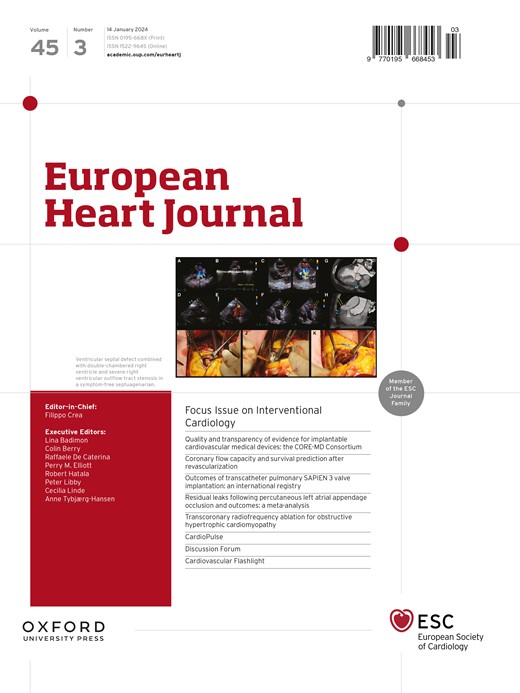Mitral valve replacement or repair and long-term risk of infective endocarditis: a Danish nationwide study.
IF 37.6
1区 医学
Q1 CARDIAC & CARDIOVASCULAR SYSTEMS
引用次数: 0
Abstract
BACKGROUND AND AIMS Infective endocarditis (IE) after mitral valve (MV) interventions is a serious complication. However, information on the long-term risk of first-time IE after MV replacement or repair is lacking. The 10-year incidence of first-time IE was examined in patients undergoing MV replacement or repair, compared with those at moderate risk of IE. METHODS Using Danish nationwide registries (2000-2020), the study population included patients undergoing isolated MV replacement or repair and patients at moderate risk of IE. The moderate-risk group included cardiac implantable electronic devices, congenital heart valve anomalies, hypertrophic cardiomyopathy, rheumatic heart diseases, and non-rheumatic degenerative valve diseases. The Aalen-Johansen estimator and cause-specific Cox regression models were used to determine the 10-year comparative incidences of IE. RESULTS The study population included 1220 patients undergoing MV replacement, 3239 undergoing MV repair, and 209 517 at moderate risk of IE. The 10-year cumulative incidences of IE were 6.1% [95% confidence interval (CI) 4.8%-7.7%] for MV replacement, 1.6% (95% CI 1.1%-2.1%) for MV repair, and 1.7% (95% CI 1.6%-1.7%) for the moderate-risk group. Compared with the moderate-risk group, after multivariable adjustment, MV replacement was associated with a higher 10-year IE rate (hazard ratio 3.52, 95% CI 2.73-4.52), whereas MV repair was not associated with IE (hazard ratio 0.76, 95% CI 0.56-1.04). CONCLUSIONS In this nationwide study, MV replacement was associated with a 3.5-fold increased 10-year IE rate, whereas MV repair was not significantly associated with IE, compared with patients at moderate risk of IE. These findings highlight the need for further investigation into preventive measures, including targeted antibiotic prophylaxis.二尖瓣置换术或修复术与感染性心内膜炎的长期风险:一项丹麦全国性研究。
背景与目的二尖瓣手术后感染性心内膜炎(IE)是一种严重的并发症。然而,关于中动脉置换术或修复后首次发生IE的长期风险的信息是缺乏的。在接受中压置换术或修复术的患者中,与中等风险的患者相比,研究了10年首次IE的发生率。方法使用丹麦全国登记(2000-2020年),研究人群包括接受孤立MV置换或修复的患者和中度IE风险的患者。中度危险组包括心脏植入式电子装置、先天性心脏瓣膜异常、肥厚性心肌病、风湿性心脏病和非风湿性退行性瓣膜疾病。使用aallen - johansen估计器和病因特异性Cox回归模型来确定10年IE的比较发病率。结果研究人群包括1220例中压置换术患者,3239例中压修复术患者和209 517例中度IE风险患者。10年累积IE发生率在MV置换术组为6.1%[95%可信区间(CI) 4.8%-7.7%], MV修复组为1.6% (95% CI 1.1%-2.1%),中等风险组为1.7% (95% CI 1.6%-1.7%)。与中等风险组相比,经多变量调整后,MV置换与较高的10年IE发生率相关(风险比3.52,95% CI 2.73-4.52),而MV修复与IE无关(风险比0.76,95% CI 0.56-1.04)。结论:在这项全国性的研究中,与中度IE风险的患者相比,中压置换术与10年IE发生率增加3.5倍相关,而中压修复与IE无显著相关性。这些发现强调需要进一步调查预防措施,包括有针对性的抗生素预防。
本文章由计算机程序翻译,如有差异,请以英文原文为准。
求助全文
约1分钟内获得全文
求助全文
来源期刊

European Heart Journal
医学-心血管系统
CiteScore
39.30
自引率
6.90%
发文量
3942
审稿时长
1 months
期刊介绍:
The European Heart Journal is a renowned international journal that focuses on cardiovascular medicine. It is published weekly and is the official journal of the European Society of Cardiology. This peer-reviewed journal is committed to publishing high-quality clinical and scientific material pertaining to all aspects of cardiovascular medicine. It covers a diverse range of topics including research findings, technical evaluations, and reviews. Moreover, the journal serves as a platform for the exchange of information and discussions on various aspects of cardiovascular medicine, including educational matters.
In addition to original papers on cardiovascular medicine and surgery, the European Heart Journal also presents reviews, clinical perspectives, ESC Guidelines, and editorial articles that highlight recent advancements in cardiology. Additionally, the journal actively encourages readers to share their thoughts and opinions through correspondence.
 求助内容:
求助内容: 应助结果提醒方式:
应助结果提醒方式:


